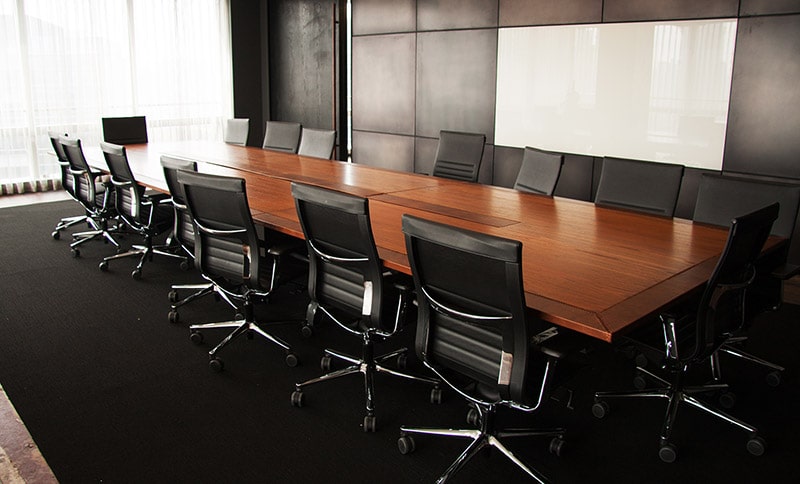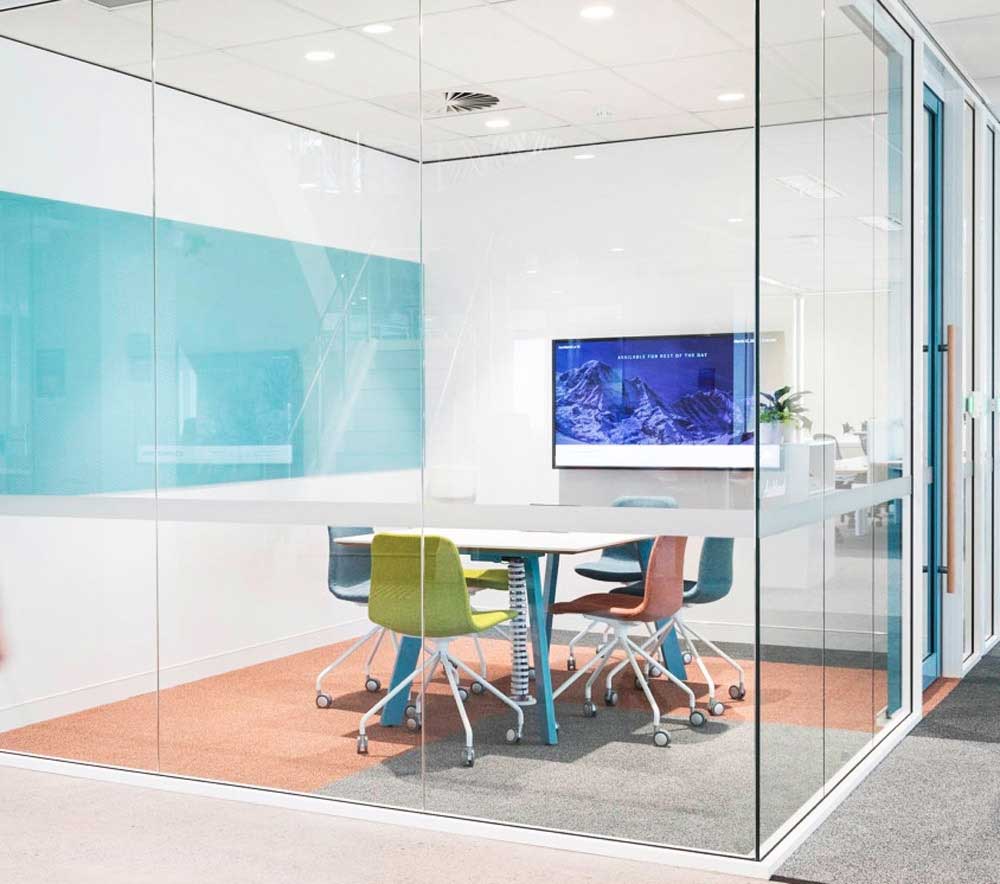Collaborative meetings are more common now than ever. Driven by new technology, it’s increasingly easier to work with your team towards shared goals. And collaborative spaces are no longer restricted to meeting rooms. They can now include just about anywhere set up as a huddle space. But the over-arching trend is the shift towards larger displays – and more displays overall.
Read on for everything you need to know about collaborative meetings or visit our solutions page for more insights into how to collaborate more effectively.
Quick. Imagine a conference room.
Chances have you pictured a large room dominated by a long table. Seating for ten or more participants. The décor: serious if not somber. A whiteboard more than likely graced the front of the room. This is the consummate image of the traditional conference room.

But get ready to imagine something new – because this reality is rapidly changing. In lockstep with an evolving work culture that calls for increased collaboration, the ways we meet are rapidly shifting. To accommodate these changes, organizations are developing a range of collaborative meeting spaces. Many of which are displacing that traditional conference room.
Trends Fueling Collaborative Meeting Spaces
Across the world, billions of meetings are called every day. Recently, business meetings have begun to leverage new technologies. This reflects the changing ways we collaborate. Many of the whys of business meetings remain the same – to brainstorm, train, develop strategy, and the like. The where and how of meetings, however, are undergoing a significant shift. This, in turn, is having a major impact on companies’ conference room strategies.
Key Trends impacting meeting room strategy are:
- The Freedom to Work from Anywhere
- Shifts in Communication Preferences
- Software-based Communication Solutions
- A Tech-native Workforce Accustomed to Flexibility
The Freedom to Work from Anywhere
Ushered in by the laptop, mobility laid the foundation for the sea change in the way we work. Today, powerful mobile devices let us take work wherever we go. Our laptops, tablets, and smartphones are our constant companions. Sophisticated mobility software and advanced data security have further enabled new options for when and where we work.

Once the privilege of a few key players, flexible work arrangements are increasingly common. For example, work-at-home time among the non-self-employed grew 103% between 2005 – 2015. Mobile device effectiveness and social acceptance have converged. This created a climate that no longer required everyone to be physically present to conduct a successful meeting. Collaborative meetings can now span continents and conference tables with virtually equal ease.
Shifts in Communication Preferences
Cloud-based personal communication services have altered the ways in which business workers choose to connect. Among the top players: Skype for Business, Zoom, GoToMeeting, and Jabber. Easy instant messaging (IM) and personal and group video conferencing solutions add to the options.

Together, these technologies are fueling rapid change. Structured, scheduled meetings are giving way to short, ad hoc, on-demand or just-in-time exchanges. Collaborative meetings now convene on a dime, when inspiration strikes.
Software-based Communication Solutions
The communication solutions that bolster collaborative meetings are becoming more robust. Mobile workers and distributed teams have become more efficient thanks to the shift from hardware to software-based architectures. This allows for a wider distribution of download-and-install audio, video, and data sharing communication clients. Anytime, anyplace and now anyone. Convening collaborative meetings is easier and more individualized than ever.
A Tech-native Workforce Accustomed to Flexibility
Millennials are the first generation to grow up surrounded by empowering technology. They now account for 30% of today’s workforce and are the largest single generation in the workplace. Digital natives, Millennials have distinctly different work styles and expectations than prior generations. They are highly motivated by peer relationships. And they’re steeped in the interactive culture of social media.

Because of this, Millennials crave collaboration and work best in teams. They require frequent feedback and have a strong desire to work with the latest technologies. The U.S. Bureau of Statistics projects that Millennials will make up 40% of the workforce by 2020, and 75% by 2025. Clearly, the need to support a collaborative workplace climate will continue to increase. Highly collaborative meetings are here to stay.
A Greater Focus on Collaborative Meetings
Collaborative meetings aren’t just more fun for Millennials. Decades of research have demonstrated that collaboration yields far-reaching business benefits. Among the benefits of workplace collaboration are:
- Faster, more efficient problem solving
- Increased innovation, trust, and loyalty
- A greater sense of purpose and ownership
- Enhanced skill development
- Improved job satisfaction and employee retention.
Awareness of these benefits has increased in recent years. Along with it comes the drive to facilitate greater collaboration. This, in turn, has had a major impact on meeting room strategy. The need to develop spaces for collaborative meetings has taken center stage.
The Open Floor Plan
Open-plan workspaces have been replacing cubicles for the past decade. They are now an iconic symbol of the modern workplace environment. Around 70% of all U.S. offices include some type of open floor plan. The flexibility of open floor plans is a natural fit for today’s mobile employees, who often spend less time in the office.

These accessible spaces can enhance employee morale, cooperation, and flow of information among workers, management, and executives. They’re ideal for convening impromptu collaborative meetings.
Cost Containment via Space Management
Flexible work arrangements enable companies to reduce their real estate footprint to contain costs and maximize efficiency.
Cost containment initiatives are an often-ubiquitous result of ongoing financial pressures. Many companies continually seek ways to contain costs and maximize efficiency. And for many, the use of space has become a focal point of these financial pressures. Cubicles left vacant by telecommuting employees led first to a rise in hot-desking. Next came an even stronger embrace of the open floor plan. With fluid seating, the open plan maximizes existing space while minimizing costs. Combined with these strategies, mobility-powered flexible work arrangements enable companies to reduce their real estate footprint to contain costs and maximize efficiency. Anytime, anywhere, initiated-by-anyone collaborative meetings ideally support these initiatives.
Types of Collaborative Meeting Spaces
The scope of the changes discussed above is sweeping. Their impact has had broad consequences for many areas of business. Below, a brief review of the ways in which these changes are impacting physical meeting space.
Conference Rooms Are Getting Smaller
Meeting rooms have been shrinking. Analysts predict this trend toward smaller spaces will be ongoing for some time. Today, medium-sized spaces that seat up to 10 participants account for 44% of all conference rooms. Small spaces that seat up to four account for 26% of all meeting spaces. The largest rooms holding 10+ people comprise 30% of all conference rooms. Smaller is better for the objectives of today’s collaborative meetings.

Comfort and Coziness Promote Collaborative Meetings
Comfort and a friendly feel have become key attributes of the modern collaborative meeting space. Today designers work to create a relaxing atmosphere that promotes comradery, comfort, and collaboration. As one designer put it, “Gone are the long tables and high-backed chairs. Enter the couches, coffee tables, easy chairs, and pillows.”
Meeting Space is Still Essential
Mobility and personal collaboration solutions continue to shape workforce strategies. Nonetheless, companies still need to provide on-site meeting space. This reality of this need is demonstrated by a study which revealed that 60% of attendees join audio, video, and/or web conferences from a conference room. They choose this location over their workplace desk, home office, or mobile device. Walled meeting space can also be critical for offering privacy and focus for collaborative meetings in open floor plan environments.
Hello Huddle Space
The disappearing conference room is giving way to small, convenient spaces that enable a few employees to quickly gather. Freedom from the need to reserve a conference room is a key feature. These huddle rooms facilitate informal closeness and easy collaboration. They provide an ideal environment for the type of interactions the growing Millennial workforce prefers.

Huddle rooms are a logical response to the ongoing changes in work-life dynamics and workspace management discussed above. They provide simplicity and spontaneity to collaborative meetings – and their use is growing. According to one analysts’ estimate, for every large group videoconferencing room there are now 20-25 huddle rooms. Industry observers agree that the number and use of huddle rooms are on the rise.
Collaborative Meeting Room Technology
The changing places and ways we meet are shaping the use of technology in collaborative meeting rooms. Technology deployment trends show an ongoing shift from traditional whiteboards and projectors toward new collaborative meeting technology. Chief among these technologies are:
Bigger, More Plentiful Displays
Many companies are moving from projection technology to large format displays (LFDs). A recent rundown of future meeting room tech trends listed multiple screens as the number one prediction. Multiple, large displays create an enhanced interactive presentation environment. Continued growth in this trend will be stimulated by decreasing prices as well as functional demand.
It may seem contradictory, but more displays are equally a trend for smaller meeting spaces. In fact, huddle space furniture from leading manufacturers like Steelcase now feature 2 or more displays. Any collaborative meeting space can benefit from all-in-one displays. Integrated features like webcam, dual speakers, and mic and headphone ports, offer easy video conferencing in any environment.
Collective Collaboration via Simple Software
Meeting space displays are more useful when participants can easily display content from their devices. Traditional “pass the cable” laptop connectivity is inefficient. It saps time, fragments focus and only lets one user at a time share content. Today’s best solutions are wireless. They empower an unlimited number of users to simultaneously share and control content. And they enable sharing from any Windows, Android or Apple device.
Standardizing on this type of solution saves time and boosts meeting efficiency. After a one-time app install, participants walk into meetings and begin sharing. Look for solutions that offer multiple use modes. These enable presenter-controlled sessions plus ‘equal-access-for-all’ collaboration. Centralized IT administration keeps management simple. The ability to integrate with existing in-room AV control systems like Crestron, Extron, and AMX is another key feature.
Changing Workstyles Call for Collaborative Meeting Spaces
The way we meet is beginning to look a lot different. Key factors in this are changing demographics, new technologies, social trends, and financial imperatives. Workers are no longer constrained to the formal, scheduled conference room.
Nonetheless, effective meetings remain critical to business productivity. In fact, collaborative meetings have increased in importance. For them to be successful, companies must provide appropriate meeting space and technology.
To address today’s needs, conference rooms are becoming smaller, more comfortable, and adaptable. Technology to facilitate effective meeting collaboration includes large format displays, interactive displays, and easy, wireless content sharing software.
If you have found this article to be helpful, you may also be interested in our piece on secure collaboration in a global business environment. Otherwise please feel free to visit our collaboration solutions page for more valuable insights and information regarding business collaboration.